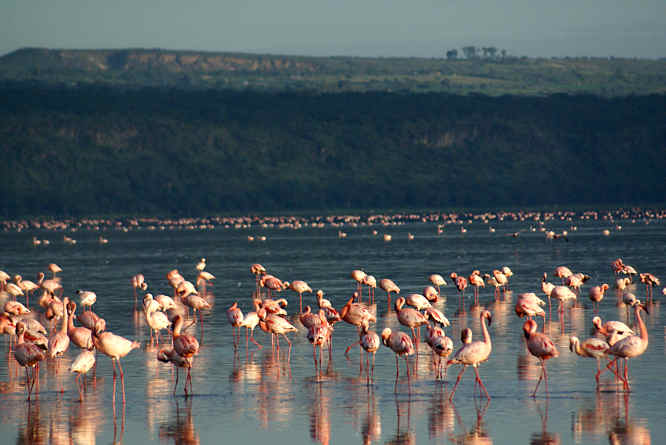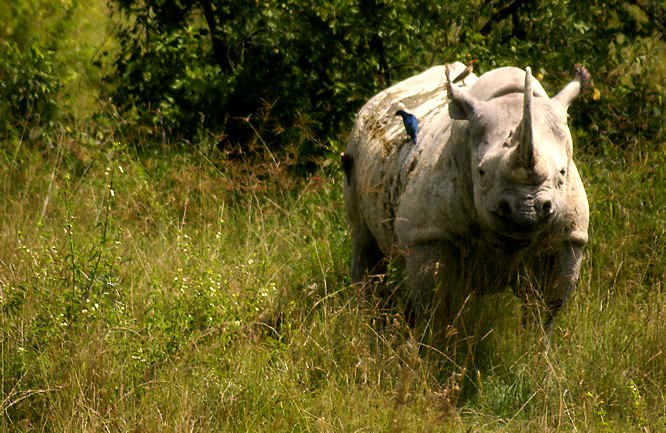Lake Nakuru National Park Kenya
Lake Nakuru National park is run by the Kenya Wildlife Service. Three major rivers and several springs along the shore drain into the very large blue-green soda lake. Because of the high evaporation rate caused by the hot equatorial sun the shallow water becomes strongly alkaline.

Dense blooms of aquatic Cyanophyte Spirulina Platensis thrive in these conditions. It may have an unpronounceable name but the long legged pink flamingos feast on this sludge. It is their major food source. Great areas of the lake appear to turn pink.
Thousands of flamingos in huge brightly coloured noisy flocks can be seen feeding, flying, landing, mating, or just strutting in the shallow water. It is a timeless photogenic fabulous sight.

Black and White Rhino
The park is also one of the few places on this planet where you can easily see black and white rhino in the wild. For this reason alone Lake Nakuru National Park must be on your list of places to visit before you die. The added advantage is it is a 4x4 enthusiast's heaven. Like many other National Parks in Kenya there are no tarmac covered roads. If you want tarmac roads on a safari go to South Africa. This is the real thing.
The main loop around the lake is a gravel road that also extends southwards into the jungle. The fun begins when you start to explore the minor tracks. These are terracotta red earth roads, once flat but now reshaped by flood water in the rainy season. There are tracks that go nearly vertical up the side hills that surround the park and lake. They really test your four wheel drive. The view at the top is worth the effort. We also nearly bumped into a Black Rhino feeding on the young bushes high up on top of the hill.
White Rhino have wide square mouths for grazing on grass. The word white in the name 'White Rhinoceros' derives from the Afrikaans word for 'wide' rather than the color white. They can be spotted on the valley floor. Look for Black Rhino in the bush. The have pointed hook lips which they use for ripping leaves and twigs off tree branches and shrubs.
Although this Rhino is referred to as black, it is actually more of a grey, brown or white color in appearance depending on the colour of the last mud pool it wallowed in. The name of the species was chosen to distinguish it from the White Rhinoceros.
Lake Nakuru is a very shallow strongly alkaline lake 62 km2 in extent. It is set in a picturesque landscape of surrounding woodland and grassland next to Nakuru town. The landscape includes areas of marsh and grasslands alternating with rocky cliffs and outcrops, stretches of acacia woodland and rocky hillsides covered with a Euphorbia forest on the eastern perimeter. The lake catchment is bounded by Menengai crater to the north, the Bahati hills to the north east, the lion hill ranges to the east, eburu crater to the south and the mau escarpment to the west.
Three major rivers, the njoro, makalia and enderit drain into the lake, together with treated water from the town's sewage works and the outflow from several springs along the shore. Lake Nakuru was first gazetted as a bird sanctuary in 1960 and upgraded to National Park status in 1968. A northern extension was added to the park in 1974 and the lake was designated as a Ramsar site in 1990. The foundation of the parks food chains is the cyanophyte spirulina platensis which can support huge numbers of lesser flamingo.
Travel books

